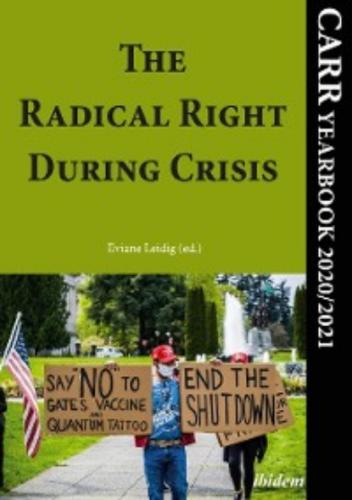The Radical Right During Crisis. Группа авторов
Monika Hübscher is a Doctoral Fellow at CARR and doctoral candidate in German and European studies at Haifa University.
1 Ben Night, “German Synagogue Attacker Trial Reveals Police Failure,” Deutsche Welle, September 9, 2020, https://www.dw.com/en/german-synagogue-attack-trial-reveals-police-failures/a-54870086.
2 “Germany: Halle Suspect Confesses to Yom Kippur Shooting,” Deutsche Welle, October 11, 2020, https://www.dw.com/en/germany-halle-suspect-confesses-to-yom-kippur-shooting/a-50791324.
3 Valentin Hacken (@valentinhacken_), Twitter, September 8, 2020, 11:36 a.m., https://twitter.com/valentinhacken_/status/1303266013551767553.
4 Andre Oboler, “Online Antisemitism 2.0. ‘Social Antisemitism’ on the ‘Social Web’,” Jerusalem Center for Public Affairs no. 67 (2008), https://jcpa.org/article/online-antisemitism-2-0-social-antisemitism-on-the-social-web/.
5 Andre Oboler, “Recognizing Hate Speech: Antisemitism on Facebook,” Andre Oboler, March 21, 2013, http://www.oboler.com/?p=1557.
6 Craig Timberg and Elizabeth Dwoskin, “As QAnon Grew, Facebook and Twitter Missed Years of Warning Signs About the Conspiracy Theory’s Violent Nature,” The Washington Post, October 3, 2020, https://www.washingtonpost.com/technology/2020/10/01/facebook-qanon-conspiracies-trump/.
7 Julia DeCook, “QAnon Has Gone from Fringe Conspiracy to Full-Blown Cult,” CARR Insight Blog, September 14, 2020, https://www.radicalrightanalysis.com/2020/09/14/1-3-2/.
8 ILTV—Israel News, “Anti-Semitism on Social Media—Professor Gabi Weimann,” YouTube video, posted July 23, 2020, https://www.youtube.com/watch?v=N5kv91AgQWY.
9 Gabriel Weimann and Natalie Masri, “Research Note: Spreading Hate on TikTok,” Studies in Conflict & Terrorism (2020): 1-14.
10 Pascale Davies, “Germany Slams Attempt to Storm Reichstag After COVID-19 Protest,” Euronews, August 30, 2020, https://www.euronews.com/2020/08/29/thousands-of-anti-corona-protesters-flood-berlin.
11 Richard Rogers, “Deplatforming: Following Extreme Internet Celebrities to Telegram and Alternative Social Media,” European Journal of Communication 35, no. 3 (2020): 213–29.
12 Celia Jean, “Germany’s Antisemitism Czar Calls to Investigate German Celebrity Chef,” Jerusalem Post, July 25, 2020, https://www.jpost.com/diaspora/antisemitism/germanys-antisemitism-czar-calls-to-investigate-german-celebrity-chef-636301.
13 Davies, “Germany Slams Attempt to Storm Reichstag after COVID-19 protest”.
Does Norway Have a Neo-Nazi Terrorist Problem?
Mette Wiggen
A young man, Philip Manshaus, who carried out the terror attack in Norway on 10 August 2019 was sentenced to twenty-one years “preventative detention”. He was charged with killing his stepsister, Johanne Ihle-Hansen, and an act of terrorism for attacking the Al Noor mosque in Bærum, Norway. At the trial, he showed no remorse, noting that he wished he had done more damage and regretted not having planned the attack better. He had in fact turned up the day before Eid-ul-Adhah to an empty mosque and was tackled and stopped by Mohammad Rafiq and Mohammed Iqbal Javed, the only people there. The prosecutor, Johan Øverberg, said Manshaus had proven to be an extremely dangerous man. There was a racist motive behind the murder: his stepsister had been adopted from China, and the attempted attack of the mosque itself had racial overtones. As noted by the German international broadcaster, Deutsche Welle: ‘in his concluding remarks, the attacker said he expected to be convicted and given a long sentence, “but I would like to point out to the judges that they are accomplices to the ongoing genocide of the European people”’.1
Over the last year the picture of how Manshaus became radicalised has become clearer; he seems to have acted alone and as other right-wing ‘lone wolves’ became radicalised online. He was a great admirer of Brenton Tarrant, who carried out the terror attack on two mosques in Christchurch, New Zealand on 15 March 2019 and killed fifty-one worshippers, and of another right-wing extremist, Anders Behring Brevik, who killed seventy-seven (mostly young) people in and near Oslo, Norway on 22 July 2011. There is no evidence he was part of a larger network but Manshaus had met with high ranking members of the neo-Nazi organisation, the Nordic Resistance Movement (NRM), in a café in Oslo a month before the attack and asked to join the organisation.2 The journalist and author of Nynazister blant oss (Neo-Nazis Among Us), Harald S. Klungtveit, argues the main reason Manshaus wasn’t a member by the time of the attack was not because the NRM didn’t want him, but because of delays in NRM’s membership system as well as internal conflicts and a split of the organisation.3
Luckily, Manshaus’ plans to kill Muslims during prayer were a failure, with him appearing on the wrong day and being apprehended by the only two men who were in the mosque who managed to stop him and contact the police. It took the police a long time to turn up, which looked like a repeat of the police’s reaction to the phone calls about Breivik and has now led to an investigation of the matter by an expert committee.4 The delay has been interpreted as racial profiling according to some, there are also other calls for Bærum police force to be investigated on accounts of racism.5 The Norwegian security service’s (PST) investigation of the police’s delay and behaviour in the Manshaus case was delayed because of the coronavirus pandemic and regretfully the report wasn’t ready at the time of Manshaus’ court case.6
More information has revealed since the trial. Notably, that Manshaus increased his online activities dramatically after he came back from a college gap year in May 2018. He had spent the academic year 2017-2018 at a liberal residential craft school, named Fosen Folkehøgskole, on a peninsula in the picturesque Trondheim fjord. The college’s ethos is about living sustainably and teaches sailing, boat building, farming, self-sufficiency, and organic living. It has a reputation of being a leftist, alternative utopic paradise. The school’s ambitious aim is to ‘guide the world in a more environmentally friendly direction’.7
Manshaus subsequently attended the stream that teaches sustainable living and self-sufficiency. The school is a very tightly knit community with activities and trips on the weekends. Students who knew Manshaus said they had noticed how he had changed during his stay at the college and they had begun to fear that someone would get killed soon: either Manshaus or somebody else. They said he expressed more and more radical views and became increasingly religious (Christian). His head
